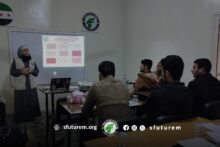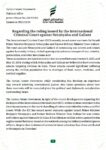Areas outside Syrian regime control, and the failure to find an alternative

Introduction:
The Syrian people’s grassroots movement, and its collision with Syria’s political reality, has led to the emergence of several entities that have established themselves as governing authorities over portions of the country.
Today, we see three authorities outside of Syrian regime control: the opposition, Hay’at Tahrir al-Sham, and the Syrian Democratic Forces (SDF). Since 2018, these authorities have solidified, reaching significant levels of entrenchment by 2020. With large-scale battles becoming rare, these entities have turned their focus toward establishing an alternative to the Syrian regime’s authority.
However, these factions appear unsuccessful in attracting Syrians, convincing the international community, or even achieving genuine empowerment. Their authority largely hinges on the decisions of intervening nations, and their existence or dissolution depends on these states’ positions regarding the Syrian opposition.
But what is the reason behind these groups’ failure to offer a convincing alternative to Assad’s authoritarian regime?
Fundamental Reasons:
The previous question in the introduction requires a careful breakdown of Syria’s complex situation. The answer is not straightforward, as it involves a series of interrelated factors:
- Complexity of the Conflict: The conflict in Syria is not a conventional struggle between a regime and opposition forces. Instead, it has evolved into a proxy war involving major regional and international powers, which has fragmented the opposition and multiplied agendas.
- Diversity within the Opposition: The Syrian opposition is not a homogeneous bloc; rather, it consists of various factions, each with its own ideology and interests. This diversity has made it challenging to reach a shared vision or a unified stance.
- Conflicting External Support: The Syrian opposition has received military and financial support from different countries, but this support has been neither consistent nor unified. Instead, it led to competition among factions and undermined their ability to work collectively.
- Absence of State Institutions: The collapse of Syrian state institutions has created a substantial vacuum, making it difficult for the opposition to establish an effective alternative.
- External Interventions: Regional and international interventions have added to the complexity of the Syrian conflict, prolonging the war and complicating resolutions.
- Economic and Humanitarian Conditions: The deteriorating economic and humanitarian situation in Syria has significantly impacted the opposition’s ability to present an attractive alternative for the Syrian people and the international community.
In addition to these factors, there are other challenges that contribute to the difficulty of finding an alternative to the Syrian regime, such as fear of the unknown. Many Syrians worry about the potential chaos that could ensue if the regime collapses, preferring relative stability even if it’s under a dictatorship.
Moreover, the absence of unified leadership has hindered the opposition’s ability to produce a competent and popular leadership capable of taking charge.
Corruption and favoritism within certain opposition factions have also weakened their credibility.
Finding an alternative to the Syrian regime is a significant and complex challenge. It requires doubled efforts from all involved parties, both inside and outside Syria, especially when comparing the Syrian situation with other Arab Spring revolutions. Despite shared points, the Syrian revolution exhibits unique characteristics that set it apart from other Arab revolutions.
Points of Similarity:
- Root Causes: All Arab revolutions, including Syria’s, erupted due to common reasons like corruption, unemployment, political repression, and lack of freedoms.
- Demands: The core demands were similar, including the overthrow of oppressive regimes, the establishment of democracy, and the improvement of living conditions.
- External Interventions: All revolutions faced foreign interventions by regional and international powers, which complicated the situations and delayed solutions.
Points of Difference:
- Violence: The Syrian revolution witnessed a level of violence far greater than other revolutions, evolving into a large-scale war, resulting in massive destruction and heavy human losses.
- Complex External Interventions: External interventions in Syria were more complex and varied, with multiple regional and international powers involved, leading to a divided opposition and sometimes strengthening the regime.
- Sectarianism: The Syrian regime exploited sectarian and religious divisions to deepen social fragmentation, which prolonged the conflict.
- International Support: The Syrian opposition did not receive the same level of international support that other opposition movements did, weakening its stance.
- Regional Impacts: The Syrian conflict had extensive regional repercussions, destabilizing the area and contributing to the rise of terrorist organizations.
The reasons behind these differences primarily stem from the nature of the regime itself, as Assad’s regime is among the most authoritarian and repressive in the region, making it highly resistant to change.
Additionally, Syria’s significant religious, sectarian, and ethnic diversity allowed the regime to exploit these divisions to deepen societal fragmentation.
Geography and history also play a role. Syria’s strategic location has made it a target for foreign interventions. The history of the Arab-Israeli conflict, along with Soviet and American interventions in the region, further complicated the Syrian situation.
In short, the Syrian revolution was unique due to a combination of overlapping factors, making it more complex and bloodier than other Arab revolutions.
Barriers to Creating an Alternative:
The Syrian opposition faced numerous and interconnected limitations that prevented it from becoming a successful alternative to the regime, summarized as follows:
- Diversity and Division: The opposition factions were diverse with varying agendas, which made it difficult to reach a common vision and unified stance. This division led to internal conflicts, weakening the opposition and distancing it from popular support.
- Lack of Unified Leadership: The opposition failed to produce a unified leadership with the necessary competence and popularity to take charge. This lack of clear leadership resulted in fragmented efforts and reduced impact.
- Dependence on External Support: Heavy reliance on external support undermined the independence of the opposition and made it a tool in the hands of supporting states, impacting its credibility and ability to make independent decisions.
- Absence of a Clear National Project: The opposition failed to present a comprehensive national project that could unite the diverse segments of Syrian society and outline the country’s future. The lack of a clear vision hindered its ability to attract widespread support.
- Foreign Interventions: The interventions of regional and international powers in the Syrian conflict added to its complexity and prolonged the war, weakening the opposition and making it easier for the regime to remain in power.
- Corruption and Patronage: The spread of corruption and patronage within some opposition factions undermined its credibility and led to a loss of trust from the public.
- Lack of Administrative Experience: Many opposition factions lacked the administrative experience necessary to manage the areas they controlled, which worsened humanitarian and economic crises.
- Extremism: The emergence of extremist factions within the opposition tarnished its reputation and made it unacceptable to large segments of the population.
- Focus on Militarization: The opposition initially focused on the military aspect, neglecting political and diplomatic efforts.
Additionally, other factors contributed to the opposition’s failure, including the complexity of the conflict and its transformation into a proxy war, which added layers of complexity and distanced it from the original goals of the revolution.
Furthermore, the opposition did not enjoy complete popular support, as part of the population preferred stability over the risks of change. Others distanced themselves from influencing the creation of a new alternative authority that would emerge democratically from the people.
These combined reasons weakened the opposition and left it unable to present a convincing alternative to the regime.
Negatives and Disadvantages:
The Syrian opposition’s inability to present a compelling alternative to the regime stands out as one of the primary challenges facing the Syrian revolution. This has led to a series of negative outcomes that have significantly impacted the course of events, including:
- Prolonged Conflict: The absence of a convincing alternative has prolonged the armed conflict, resulting in increased human and material losses and the destruction of the country’s infrastructure.
- Strengthening the Regime’s Grip: In the absence of an appealing alternative, the Syrian regime has managed to strengthen its hold on power and reclaim control over vast areas.
- Deepening Divisions: Internal disagreements within the opposition and the lack of a unified vision have intensified sectarian and ethnic divides within Syrian society.
- Worsening Humanitarian Conditions: Ongoing conflict and deteriorating economic conditions have worsened the humanitarian crisis, displacing millions of Syrians.
- Increased Influence of Foreign Powers: Regional and international forces have exploited the political vacuum in Syria to expand their influence, further complicating the crisis.
- Decreased International Support for the Opposition: The opposition’s failure to present a credible alternative has diminished international support, weakening its negotiating position.
- Rise of Extremism: The security vacuum has led to the rise of extremist groups, which has tainted the image of the Syrian revolution.
- Delays in Political Transition: The lack of a viable alternative has postponed Syria’s political transition, increasing the suffering of the Syrian people.
- Questioning the Revolution’s Legitimacy: The Syrian regime has used media and the opposition’s weaknesses to tarnish its image and cast doubt on the legitimacy of the Syrian revolution.
In summary, the Syrian opposition’s inability to present a convincing alternative to the regime has exacerbated the Syrian crisis, delayed its resolution, and undermined the chances of realizing the Syrian people’s aspirations for freedom and democracy.
Positive Aspects of the Lack of an Alternative:
There is almost a consensus among Syrians and researchers that there are no direct positives to the Syrian opposition’s failure to provide a convincing alternative to the regime. This failure has led to severe consequences for the Syrian people and the entire region.
However, this crisis can be viewed from an analytical perspective to draw some lessons and insights, such as:
- Revealing the Reality of Authoritarian Regimes: The Syrian crisis exposed the true nature of authoritarian regimes and their ability to use repression and violence to maintain power, which could increase public awareness in other countries.
- Strengthening Civil Movements: The crisis has contributed to the development of civil movements within Syria and the region, raising awareness about human rights and democracy.
- Shifting International and Regional Power Dynamics: The Syrian crisis has led to changes in international and regional power balances, which may influence the future of the region.
- An Opportunity to Rethink International Policies: The crisis has urged the international community to reassess its policies towards armed conflicts and the necessity for intervention to protect civilians.
However, it must be emphasized that these points do not negate the significant negatives that resulted from the failure of the opposition, which were previously mentioned in the earlier response.
It is also important to note that this crisis is ongoing, and the situation in Syria is subject to change. New developments may arise in the future that could affect the course of events.
Therefore, the focus should be on finding political solutions to the Syrian crisis, ensuring the preservation of the country’s unity, achieving a peaceful political transition, and respecting human rights.
However, in the political office of the Syrian Future Movement, we see a positive aspect overlooked by many. The existence of an alternative to the Syrian regime means that one of these three authorities is sustainable or acceptable to the Syrians, which could negate the larger goal of Syrian success: building a strong national state.
From the Syrian Democratic Forces (SDF) to Hayat Tahrir al-Sham (HTS), and then the mismanagement of the National Army, the Coalition, and the Interim Government, none of these are healthy alternatives to the oppressive regime, nor should they be. Therefore, the failure of these opposition factions to create a viable alternative to the regime keeps us in continuous search for the right solution and rejecting any of these flawed projects.
Conclusion:
Although we view the failure to create an alternative positively, it is possible to sketch a general framework for the Syrian opposition to present a convincing alternative to the current regime. This can be achieved by working on multiple fronts and implementing a set of recommendations, including:
- Uniting Forces and Building Strong Institutions:
- A. Forming a unified leadership, where opposition factions agree on a leadership that is competent and popular, and works to represent all segments of the Syrian people.
- B. Building strong civil institutions, such as political parties and civil society organizations, capable of providing services to citizens and building trust with them.
- C. Developing a clear political program that defines the opposition’s goals and vision for Syria’s future, ensuring the achievement of transitional justice and human rights.
- Enhancing Communication with the People:
- A. Work on building trust with the Syrian people by providing services, combating corruption, and maintaining continuous communication with them.
- B. Listen to the people’s demands, meet their needs, and work on solving the problems they face.
- C. Avoid sectarian and inciting rhetoric, and work towards uniting the Syrian people.
- Securing Broad International Support:
- A. Strengthen international relations and broaden the scope of international support.
- B. Present a clear vision for Syria’s future that is convincing to the international community.
- C. Commit to democratic values and human rights to gain the trust of the international community.
- Focusing on a Political Solution:
- A. Actively participate in political negotiations and work towards achieving a political solution to the crisis.
- B. The opposition must be flexible and capable of accepting conciliatory solutions.
- C. Seek creative solutions to the crisis that take into account the interests of all parties involved.
- Building on Positives:
- A. Benefit from previous experiences and avoid repeating mistakes.
- B. Focus on the commonalities among Syrians and work on uniting them around a comprehensive national project.
In addition to these recommendations, the Syrian opposition must recognize that building a credible alternative to the current regime requires time and effort. There are many challenges they face, but with determination and resolve, these obstacles can be overcome to achieve the desired goals. Otherwise, their failure to create an alternative to the Syrian regime will mean that Syrians will need an alternative to both themselves and the regime, equally.
Political Office
Research Team
Department of Research and Studies
Articles
Syrian Future Movement






